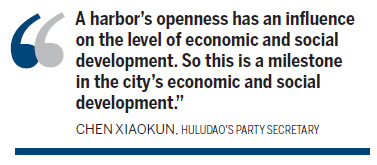Liaoning Special
Breaking the bottleneck on the Bohai Sea
By Wu Yong and Liu Ce (China Daily)
Updated: 2010-12-02 07:58
 |
Large Medium Small |

The port city of Huludao, on Liaoning's coast, passed a national inspection and was certified on Nov 23, putting an end to the long history of no foreign ships stopping there.
"A harbor's openness has an influence on the level of economic and social development," said Chen Xiaokun, Huludao's Party secretary. "So this is a milestone in the city's economic and social development."
Huludao sits on Liaodong Bay, with the Bohai Sea to the southeast of the city. The harbor was originally built in 1908 as a wide, deep shelter from the winds.
After 1949, it became an important military harbor and, in 1960, the Bohai Ship Building Factory began operation, as an important Chinese industrial base.
However, with the military and civilians both using the port, there was an economic development bottleneck and it needed to enlarge and open up.
These days, many local companies and those farther inland depend a lot on the port for raw material imports from overseas and for exporting goods.
The Huludao Zinc Factory, for example, imports 500,000 tons of lead and zinc annually, and exports 100,000 tons of zinc ingots a month.
The Jinzhou Chemistry Corp brings in 200,000 tons of industrial salts every year and sells 200,000 tons of sodium hydroxide abroad.
But, foreign ships are not allowed in and a large amount of materials can only get in making a detour through Jinzhou, Yingkou, Qinhuangdao, Tianjin, Dalian, or some other harbor.
This means longer transportation times and higher costs and a decline in competitiveness on international market. It also hinders local economic development.
"Huludao's further openness will definitely fuel local development. More important, it will open a new door for opening the coast up. It will drive Liaoning's interior development," said Liang Qidong, head of a Liaoning Social Sciences Academy research institute.
Huludao plans to have four harbor districts at Liutiaogou, Suizhong, Xincheng and Beigang. And it is thinking of a 31-kilometer-long wharf that can handle 330 million tons annually and 110 berths. The first 10 months this year saw the completion of 8.3 million tons' worth of handling capacity.